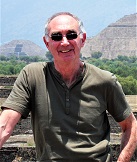


|
|
||||||||||||||||
|
|
||||||||||||||||
|
|
|||
|
|
Teotihuacán 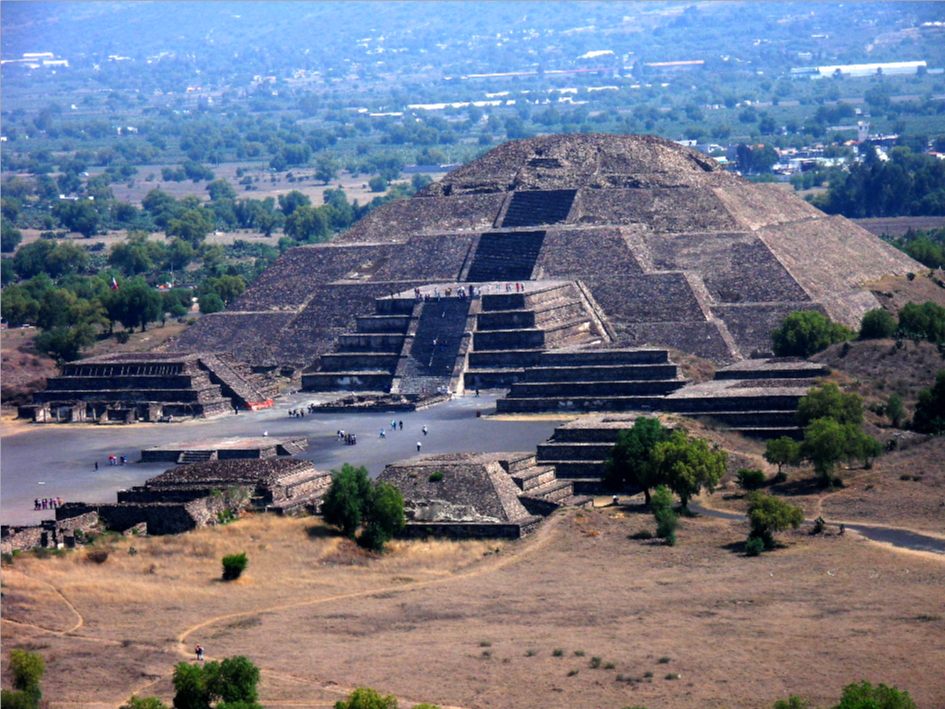
Dating back to 100 BCE Teotihuacán was to become the cultural epicentre of ancient Mesoamerica. Yet very little is known about its origins, its people and where they came from or what language they spoke, although the civilization left many architectural ruins, no trace has yet been found of a writing system. The Totonacs have always maintained that they were the ones who built it, something that was accepted by the Aztecs, although this has not been corroborated by archaeological findings. The original name of the city is also not known, Teotihuacán, which means ‘place of the gods’, was given to it by the Aztecs although they never lived in Teotihuacán but visited it as a place of pilgrimage as they believed it was the place where the world was created. Although buildings have been found that date back to 200 BCE the development of Teotihuacán began in the first century AD, which was when the Pyramid of the Sun was constructed. This development resulted from the exploitation of natural resources and an increase in agricultural production resulting in the development of trade. Between the 4th and 7th centuries, Teotihuacán was to reach its height with influence throughout most parts of Mesoamerica reaching its peak around 450 AD when it was to become one of the largest cities of the world at that time covering an area of 30 Sq km (11 sq miles) with a population of between 85,000-200,000 inhabitants. Its decline is believed to have occurred between 650 and 750 AD and evidence has been found of wilful destruction and damage by fire of some of the main buildings. Some scholars put this down to it being sacked by unknown invaders although others suggest that it may have been an uprising of the people against the elite. Teotihuacán was believed to have been a multi-ethnic city, occupied by Otomi, Zapotec, Mixtec, Maya and Nahua peoples each with their own distinct with the majority of people living in large apartments. Many of the buildings contained workshops where artisans produced pottery and other goods. At the north end of the site is the Palace of Quetzalcoatl, the Butterfly Palace, the Temple of the Feathered Conches, and the Palace of the Jaguars. 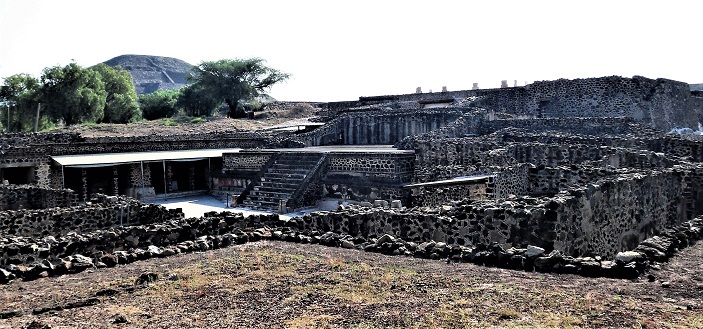 Adorning the buildings are magnificent murals and stone carvings. Much of this has been rebuilt and you can see what has been rebuilt as it has black pebbles in the mortar. Some of the rooms show rough stone yet the artwork can still be seen in places, which provide an example of the decorations that used to adorn the walls. 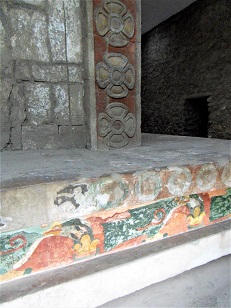 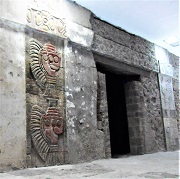 The Palace is not in fact a palace it is thought to be the place where the high priest lived and is one of a number of former residences of the nobility which have been restored and made open to visitors. It consists of a rectangular inner courtyard surrounded by wide doorways on all four sides leading into a series of rooms. On the east portico is a great antechamber with access to the Plaza of the Moon by a wide staircase. The Plaza of the Moon is in front of the 42 metres (138 ft) tall Pyramid of the Moon, which was the first large structure built in Teotihuacán. 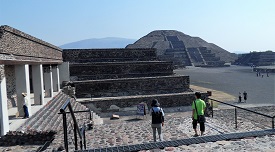 The Moon Pyramid is located at the northern end of the Avenue of the Dead, which was the main axis of the city. The Moon Pyramid was built as the principal monument of the Moon Pyramid complex which was surrounded by 15 pyramidal structures including the Moon Pyramid itself. A five-tiered platform was attached to the front of the Moon Pyramid. The pyramid does have interior structures within it, as in fact do most of the pyramids. The Moon Plaza seem to have been one of the main ritual precincts of the city. However, the pyramid remains one of the least understood major monuments in Teotihuacan. 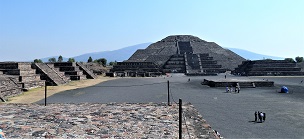 Running along the centre of the city from the Moon Pyramid complex is a broad central avenue, called "Avenue of the Dead". The avenue was 40 metres (131 ft) wide and stretched for 3 miles, although now only 1.4 miles is discernible. 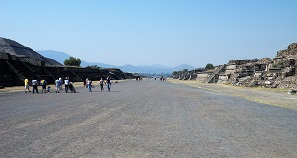 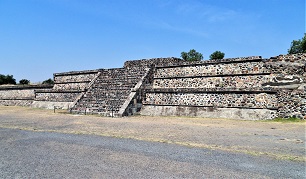 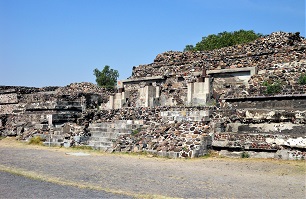 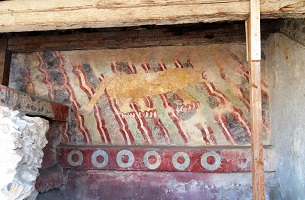 Some of the murals are still visible on the temples. At the side of the avenue is the immense Pyramid of the Sun which stands 64 metres (210 ft) tall, this was originally nearly 76 metres (249 ft) tall as it once had a temple on top.  Its base length is 225 metres (738 ft), which is just 3 metres (10 ft) less than the Great Pyramid of Cheops. Below the pyramid is a cave which it is believed gave it its special significance as this was symbolic of the womb. The Sun Pyramid was extensively excavated in the first decade of the 20th century. Since that time, two tunnels have been excavated into the core of the pyramid, providing more information about its chronology and substructure. Another extensive excavation took place in 1992-93, exposing more of the pyramid complex, especially on its north and east sides. At the side of the Avenue of the Dead is the area known as the Citadel. This was a large plaza surrounded by a wall, which allowed for controlled access it contained temples it formed the religious and political centre of the city.  The name "Citadel" was given to it by the Spanish, who believed it was a fort. A large sunken enclosure with a capacity to hold about 100,000 people, it is believed that this may have been used for ritual performances although is also thought to have been the marketplace. The interior space is surrounded by four large platforms surmounted by pyramids.  The main pyramid of the complex is the Feathered Serpent Pyramid was constructed around 200 AD. 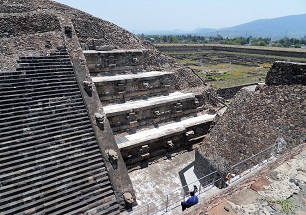 It was the last major monument to be built in the city. It was built after a number of previous structures on the site had been demolished, and a number of sacrificial graves had been installed. The pyramid is adorned with large sculptural heads and is in the process of being restored and also had many brilliantly painted frescoes. Many monuments and archaeological sites throughout the world have long been targets of looting activities over the centuries and Teotihuacan was no exception. Archaeological projects in the 1980s discovered a tunnel inside the Feathered Serpent Pyramid. The excavations revealed that two multiple burials near the centre of the pyramid had been looted by gaining access through the tunnel. Carbon dating of some of the remains that the looters left indicated that the looting did not begin with the collapse of the city but when the city was inhabited. The first major excavations in the city were undertaken by Leopoldo Batres in 1905, since then there have been numerous excavations and the site was designated a UNESCO World Heritage Site in 1987. The site also has a museum which contains many artefacts from the site and of course, it also has souvenir shops and stalls.
See Teotihuacan in Panoramic View Additional information can be found in Encyclopaedia Britannica |
|
|
|
|
|||
All Photographs were taken by and are copyright of Ron Gatepain
| Site Map |
